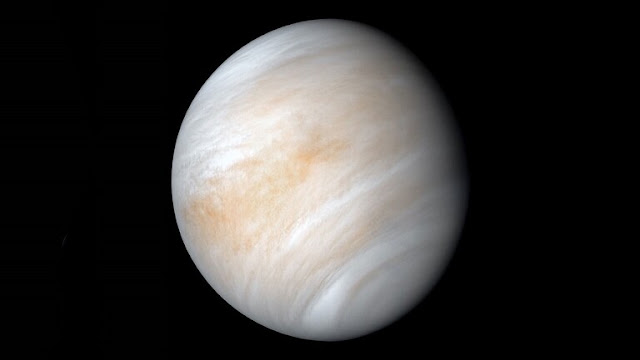 |
Venus is a mystery to astronomers, and although it is adjacent to Earth, it reveals little about itself.
The planet is known for its opaque cloud cover that subdues harsh landscapes that are bombarded by acid rain and baked at temperatures that can lead to smelting lead.
Now, the new observations are lifting the veil on some of the basic characteristics of Venus. By repeatedly bouncing radar off the planet's surface over the past 15 years, a team led by the University of California, Los Angeles, determined the exact length of a day on Venus, the tilt of its axis, and the size of its heart. The results are published today in Nature Astronomy.
"Venus is our sister planet, yet these basic properties remain unknown," said Jean-Luc Margot, professor of Earth, Planetary and Space Sciences at the University of California, who led the research.
Earth and Venus have a lot in common, as all rocky planets have roughly the same size, mass, and density. Yet it has evolved along completely different paths. Fundamentals such as the number of hours on the day of Venus provide important data for understanding the varying dates of these neighboring worlds.
Changes in the rotation and direction of Venus reveal how the mass is spread inside. Knowledge of its internal structure, in turn, provides insight into the planet's formation, its volcanic history and how time changed the surface. In addition, without accurate data on how the planet is moving, any future landing attempts could be halted by as much as 30 kilometers.
New radar measurements show that the average day on Venus lasts 243,0226 Earth days, roughly two-thirds of Earth's year. What's more, the rate of Venus’s rotation is always changing: a value that is measured simultaneously will be slightly larger or smaller than the previous value. The team estimated the length of the day from each individual measurement, and observed differences of at least 20 minutes.
"That may explain why previous estimates do not agree with one another," Margot said.
The cause of the heavy atmospheric difference is that Venus as it slows around the planet, it is exchanging a lot of momentum with the solid Earth, which causes it to accelerate and slow its rotation. This happens on Earth, too, but the exchange only adds or subtracts one millisecond each day.
The effect is even more dramatic on Venus because the atmosphere is about 93 times larger than the mass of Earth, and thus has more momentum for circulation.
The University of California team also reported that Venus is tilted to one side with an accuracy of 2.6392 degrees (the Earth is tilted by about 23 degrees), an improvement in the accuracy of previous estimates by a factor of 10.
Repeated radar measurements revealed the rate of ice, as the direction of Venus' rotation axis changes.
On Earth, this "initiative" would take about 26,000 years to rotate once. Venus needs a little longer, estimated at 29,000 years.
Through these precise measurements of how Venus rotates, the team calculated that the planet's nucleus has a diameter of about 3,500 kilometers, exactly like Earth, although they cannot yet conclude whether it is a liquid or a solid.
Source: phys
Read also :

Comments
Post a Comment